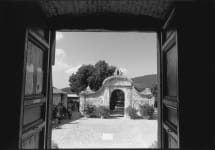Garofoli Podium Verdicchio dei Castelli di Jesi 2020
- Vinous
-
Wine
Spectator
Last call - only 2 left!




Product Details
Your Rating
Somm Note
Winemaker Notes
Straw yellow in color with intense, elegant and fruity aromas with hints of citrus. Persuasive, soft, with great character on the palate. Very long-lasting sapidity, warm and elegant.
Professional Ratings
-
Vinous
The 2020 Verdicchio dei Castelli di Jesi Classico Podium is youthfully inward and coy at first, with a dusty florality and hints of cardamom in the glass. Swirling unlocks nuances of sage and rosemary, ginger and hints of smoky cracked stones, yet its fruit, leaning toward apricot, is still quite shy. Today, this impresses more on the palate, deeply savory and mineral in style, with a herbal twang and sour melon which place it firmly into the green fruit spectrum, all brilliantly offset by a saturating salty sensation. The palate is left reeling with spicy tension; the 2020 finishes structured, leaving the cheeks puckered and the mouth watering thanks to a late-arriving bump of zesty acidity. This will take some time to show its best, but it will be time well spent.
Rating: 93+ -
Wine Spectator
A lovely, graceful white, with succulent acidity enlivening notes of ripe pear, anise, crushed almond and hints of Meyer lemon peel, vanilla and white blossoms. Long and well-knit, with a tang of salinity emerging to linger on the finish. Drink now through 2030. 3,300 cases made, 300 cases imported.
Other Vintages
2021- Vinous
-
Wine
Spectator
- Vinous
- Vinous
-
Wine
Enthusiast -
Robert
Parker -
Wine &
Spirits -
Wine
Spectator -
Jeb
Dunnuck
-
Wine
Enthusiast
-
Robert
Parker -
Wine
Spectator
-
Wine &
Spirits

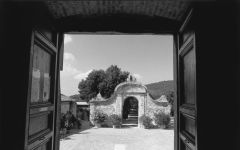
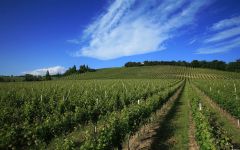
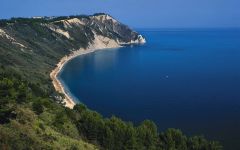
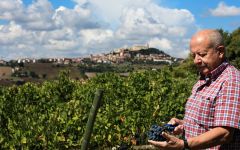
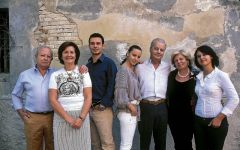

The origins of the Garofoli winery date from the end of the 19th century, when in 1871 Antonio Garofoli began the production and sale of local wines. His son Gioacchino continued to expand the business and in 1901 he founded the Gioacchino Garofoli winery. His two sons, Franco and Dante, succeeded him in management of the estate after World War II and in 1950 the Gioacchino Garofoli winery became a official company.
The late 60s through the 70s brought the addition of the Serra del Conte winery, specifically for Verdicchio production and the expansion of the Castelfidardo winery with underground cellar suitable for the maturation of wines in wood. There was also new vineyard acquisition, Massignano di Ancora and Paterno di Ancora in Rosso Cònero and Montecarotto in Jesi zone.
In 1973, Franco’s sons, Carlo and Gianfranco joined the company and with them came many advancements and innovations.. In the last seventies, Garofoli was the first to produce a Champenois-method sparkling wine using Verdicchio grapes. By the 1980s Garofoli began to reduce vineyard yields, to harvest grapes when they were fully ripe and obtain a Verdicchio with more complexity. They also abandoned the amphora (fish bottle) for this new Verdicchio, presenting it in a classic Bordeaux bottle. Lastly, in a time when there was little or no talk about barriques, the winery went on to experiment with the wine’s capacity to withstand extended maturation. Serra Fiorese, the first Verdicchio matured at least two years in wood and bottle was released in 1984.
In 2005 Gianluca, Catarina and Beatrice join their parents in the management of all aspects of the winery. The history of the Garofolis is a story of people and of a family that has been identified with winemaking for five generations. The same philosophy has always guided them: a constant updating of production techniques while respecting traditional and historic winemaking methods; attention to the evolution of the market and its requirements along with loyalty to the values of the special characteristics that the traditions of the territory have transmitted.

One of central Italy’s classic white grapes, Verdicchio thrives in two distinct zones of the Marche. The best vineyards of Verdicchio dei Castelli di Jesi adorn hillsides a mere 20 miles from the Adriatic Sea. The vineyards of the smaller, more inland Verdicchio di Matelica, are at higher elevation. Somm Secret—Recent genetic discoveries have proven that the Verdicchio grape is identical to Trebbiano di Soave, Trebbiano di Lugana and Trebbiano Veltenesi.

Stretching along Italy’s eastern coast with neighbors, Umbria to its west and Abruzzo to its south, Marche is a region with a varying climate from north to south. Its coastal plains roll into hills that become the Apennine Mountains, which run the length of the country. The Marche's best red wines come from the grapes, Montepulciano and Sangiovese; the local Verdicchio makes refreshing, crisp and light whites.
